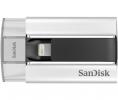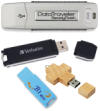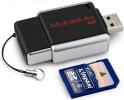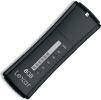Reviews related to : Flash memory
Having recently told you about a 64GB micro SD card from Toshiba, here a standard SD card and a coloured USB stick get put through their paces in a range of devices and also with computers with different operating systems.
The cards class and speed make all the difference and when shooting video from a camera is a good way to know if your class and speed is adequate. Speed used to be easy to judge with the number shown on the card 2 was around 2MB/s, 4 was around 4MB/s, 6 was around 6MB/s, 8 was around 8MB/s and the best was 10MB/s which was a 10.

San Disk iXpand Flash Drive and Cygnett ChargeUp 11000 : San Disk iXpand 32GB Flash Drive & Cygnett ChargeUP 11000
The first a 32GB stick for iPhone, iPad and computers is how this double ended memory stick is described. The second the largest capacity Portable Power Charger I have currently seen at 11000mAh with both 1amp and 2.1 outputs.
It looks like a slightly large USB memory stick and indeed it is but apart from being able to move items from one USB device to another it does something two other things. It is 3.5cm wide around 1cm thick and around 6cm long. Its width will require either a flush fitting USB port or a USB extension lead. When inserted around 4.5cm is exposed from the PC. The first extra thing is the ability to transfer files either to or from Lightning devices.
Those of us that have seen the size and weight of a hard disc fall while its capacity has increased have seen the capacity of memory sticks increase in the same way. An 8GB memory stick is almost entry level and larger ones have more capacity than a lot of older even quite recent hard drives.
Time was when to install an operating system on a new hard disc meant having a CD or DVD and doing the installation from that. More recently computer BIOS settings allow you to install from USB stick. The basic installation files of Windows 7 fit easily onto an 8GB memory stick so providing a memory stick is reliable then that’s fine.
They say small is beautiful, and in the form of a microSD card, it can also contain enough entertainment to keep me happy.
The phone in your pocket (with appropriate apologies for the original saying) has tended to grow in both power and functionality with each new version. However there is one aspect of your mobile friend that is sometimes neglected. That area is the one of storage capacity. Often manufacturers believe that by offering devices with a MicroSD card slot, the needs of their customers will be satisfied and this approach will allow them to keep their costs down.
Despite smartphone and tablets now having cameras with more and more megapixels, the results cannot match those of a good quality bridge camera and certainly not the performance of a digital SLR both of which have a range of advanced features including optical zoom. Eye-Fi Mobi, provides the best of both worlds as it enables one to use Wi-Fi to transfer camera images directly to ones smartphone or tablet.
The Mobi SDHC Class 10 cards are coloured orange and clearly state “mobi” and also their capacity – 8, 16 or 32GB. They can just replace an existing SD card in a camera and create an 802.11b/g/n Wi-Fi hotspot. Having downloaded and installed the app from www.eye.fi/mobi via the Android Play Store or the iOS app store onto the smartphone or tablet and then switched on the camera one will be prompted to key in the mobi activation code to “pair” phone and camera.
Moving files to and from a portable Apple device has always been a faff, now there is a halfway device you copy them to, and then, transfer by drag and drop to the PC and by downloading an App, from the iFlash Drive to your i device.
The PhotoFast iFlash Drive HD measures 4.7x2.5x1cm and its total weight is 8grams. These devices are available in different capacities – the one sent to me was 8GB – one end is a USB plug the other end is the standard Apple 30pin plug. For those with the very recent new connector size there is an adapter available. Transferring files from the PC is as easy as drag and drop just like to any USB stick.
A novel design for this hard drive has it sitting up in a cradle, it can be removed if you wish, however this unit has a decent front end of software that offers more than just a hard drive and even then there is a little something extra.
I have reviewed several 500GB drives and even a couple of 750GB ones which although they come with extra power leads they have not needed them, here even when the drive is out of the cradle it can need that extra boost. The main drive has a small partition which is seen as a CD enabling it to have software concealed on it. More on this software in a little bit. The usable part of the drive is 465GB with the other GB taken by pointers.
Now 1 and 2GB USB sticks are common and cost not a lot, 4GB and 8GB are almost normal but 16GB are still something a little bit special. The smaller sticks are coming in fancy clothing even as a small paperclip type device.
The size of hard discs continue to rise so people expect the size of memory sticks to keep pace. With USB3 starting to attract attention moving larger files quickly is getting ever easier. Of course the more data you carry the more disastrous the outcome should unencrypted files fall into the wrong hands. Here lets deal with size. I have seen two of these such devices at 8GB and 16GB they are not light as they are made of metal and the USB plug slides out of the casing when required.
Here I am looking at three new SD cards, one from Kingston, the second from Verbatim and the other from Integral. All are 64GB and use the new SDXC format (128GB cards will follow shortly). However you will need updated card readers to view your files.
Last year with the aid of Kingston Technology - and how to tell what the various numbers found on stood for. These covered 4GB up to 32GB. Now however there are 64GB and soon – I am told – 128GB. One word of caution if you are purchasing a 64GB or 128GB card you will need a new card reader as older readers can only recognise up to 32GB. Two of the cards I am looking at came with readers.
A put-in-your pocket memory card reader from the memory specialist Kingston that supports SD and Memory Stick formats.
While a good number of computers these days do come with built-in memory card readers this is by far from being universally the case. Here in the office my year old desktop machine for instance has no such card reader. While it's still common to see 17-in-1 card readers available, the industry has thankfully, for the most part, standardised on a couple of card formats, although with variations.
Online storage, sharing capability and a backup option from a USB Flash stick it is possible.
While you may not recognise the name of Gemalto, the chances are that you have probably used at least one of the products that have been developed by this company. In its B2B (Business to Business) persona, Gemalto produces a large percentage of subscriber identification modules (SIMs) and smart cards in use today. Developing a more consumer orientated approach, Gemalto’s latest product is entitled YuuWaa – now there’s a name you are not going to forget in a hurry.
Once you go beyond 2GB the SD card limit then choosing SDHC cards becomes more difficult as there are a number to choose from. Obviously a brand name like Kingston, Dane-Elec or San-Disc is half the battle but beyond that there are various Classes.
So what exactly do things like Class 2, Class 4, and, Class 6 mean and do they make any difference apart from the larger Class number meaning the memory is likely to be more expensive to purchase? In fact a visit to certain sites like say give you the information as to what class the card you are selecting is and certain other sites just tell you the make and maybe a card name like say Ultimate or Elite Pro and on their own this means little other than the manufacture has dug into a thesaurus

Just how many cards types are there? : 80 in 1 Card Reader and USB Multislot Card Reader/Writer both from Brando
Sometime ago I reviewed a card reader that I believe claimed to be 27 types, this to me seemed far more than I knew of. Here I am looking at two devices from Brando and one of these claims 80 while the other has 56 and another plus.
I have long transferred data by a four slot card reader and up till now it has always done what I needed. However when the ‘mini’ this and the ‘micro’ that come along they need an adapter so that they adapt to their full size cousins before they can fit in the reader. Here with six slots that is almost solved. It is 10x4.5x1.
Like socks, USB caps take on a life of their own and are expert at hiding themselves.
Verbatim has recently introduced a new range of Store'n'Go USB drives. Decked out in the company's familiar blue livery, these drives will be available in capacities of 1, 2, 4 and 8GB. I have been looking at the 4GB model which has been priced at £19.99. This new USB drive immediately solves one problem that many users of this type of device will be familiar with on a regular basis.
The Micro SD card has shot up in popularity solely because most mobile phones manufacturers (except Sony Ericsson) now use it for storage; its cheaper for them than internal memory and a lot easier for you to move photos and videos around.
However until very recently transferring to a PC has meant not only removing the micro SD card from the phone but finding the adapter to convert it into a standard SD card and also then the card reader.
Flash drives have traditionally been fairly slow devices, but like all things to do with computers
performance continues to improve over time. Here we compare two high-performance USB flash drives
from Kingston and from Imation.
From Imation we're looking at the new "Atom Flash Drive", available in 1G, 2G, 4G and 8G bytes sizes. Our
test sample is 1Gbyte. This is pitted against the Kingston Data Traveller 100, available in the same sizes.
Two forms of storage memory. The first from Dane Elec that looks exactly like a casino chip and the second from San Disc a Micro SD card reader. Both these items fit directly into a USB port.
Poker Mate USB Drive It is 4cm across and .5cm thick. It is red and white with 12 alternate sections the six white ones are plastic and the red ones rubber. This gives a distinct feel in the fingers. There are various capacities available, mine was 1GB and this is clearly written on both sides of the chip.
Flash memory is a small miracle - but it doesn't come without problems. Unlike the veritable floppy that has remain
unchanged now for over a decade, flash emory formats change more frequently than government ministers.
Apart from the obvious problems with knowing which format you need for a particular product, you're also often
left having to buy different card for each of your gadgets. Even ignoring competing formats, individual formats
have now spawned whole families of related standards sharing confusingly similar names.

USB Sticks : Verbatim USB Drive 4GB, Kingston Data Traveller 2GB, TwinMOS B1 4GB, USB Cross Wooden Memory Strap 2GB
Just over a year ago Vista was launched and memory sticks got a new job as fast storage for temporary files. When it was launched I told you about a 2GB offering from SanDisk.
There are of course others some others produced by different manufacturers some call their offerings ReadyBoost another calls it ReadyFlash. Either way they are still High Speed Flash Drives.
Verbatim USB Drive 4GB This looks like a conventional USB stick drive, just for a moment think that not long ago a 4GB hard disc would be large. It is quite able to do the job of speeding up Vista and indeed does carry the ReadyBoost name. However apart from part or all of the available space being allocated to Vista it comes with a £16.
As USB flash drives shrink in physical dimensions, they do seem to increase in storage capacity and additional features.
In an effort to differentiate their USB flash drive products from the competition manufacturers have put in varying degrees of effort into trying to make their particular products stand out from the rest of the pack. Physical dimensions and various shapes have been tried as the means of differentiating certain brands while others have opted for the approach of adding extra value in the form of bonus software such as Ceedo, U3 and encryption protection.























